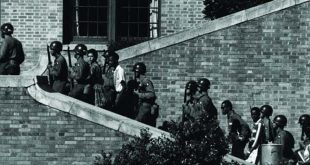Stephen Karganovic
The recent Tolimir trial verdict at ICTY generally follows the standard pattern, but some interesting departures should be noted. General Tolimir was head of the Department of Security and Intelligence at the Main Staff of the Republika Srpska army during the war in Bosnia. He was only one hierarchical step below General Mladić, and the verdict will certainly impact the Mladić case which is being heard by a different ICTY Chamber.
Incidentally, Tolimir was sentenced to life in prison for genocide (not just in Srebrenica, but also nearby Žepa, an important detail), as well as a variety of the usual other offences imputed to high ranking Serb defendants in proceedings of this nature. The striking contrast between the life sentence handed to General Tolimir and acquittals given to Gotovina, Markač, and Haradinaj indicates the extent of ethnically-based inequality of defendants before the Hague Tribunal.
One of the novelties in the Tolimir verdict are some interesting differences with regard to the number of victims compared to earlier claims made by various chambers of the Hague tribunal. The verdict cites two sets of figures which allegedly refer to the number of murdered victims. In addition, the number of victims was inexplicably reduced by about a third by comparison to the Tribunal’s earlier “adjudicated facts”, which were in effect until quite recently.
Up to the Tolimir verdict on 12 December 2012, it was an established truth at the Hague Tribunal that in the course of the Srebrenica operation Serbian forces killed “between 7,000 and 8,000 prisoners”, as asserted in Par. 84 of the Krstić appellate judgement [2004]. However, in General Tolimir’s trial verdict the number of victims was lowered to 4,970, if calculated in conjunction with the relevant charges in the Indictment, or alternatively to 5,749 if victims uncharged in the Indictment, but found by the Chamber to have been killed, are included. The number of alleged genocide victims found by the Tolimir Chamber is therefore by about a third less than the standard figure of 8,000.
What explains this unanticipated change in relation to the victim count? The new calculus gives the Chamber helpful methodological leeway and enables it to more efficiently reach the conclusion of genocide for Žepa. It should be borne in mind that for the Tribunal and its sponsors it is the finding of genocide that is of the foremost importance, not the number of actual victims. That is the Bosnian Muslims’ and Srebrenica lobby’s department. The advantage of the new approach pioneered in the Tolimir case is that it is more suitable for finding genocide in sticky situations, whatever the number of victims, not just in Bosnia but also beyond.
Accordingly, for the purpose of finding genocidal intent [mens rea] the Chamber concluded that it is unnecessary to prove “the intent to kill a minimum number of victims” [Par. 726]. The concept of the “group” targeted by the genocidal operation is deliberately left vague so that it may be “made on a case-by-case basis, using both objective and subjective criteria”. It is sufficient, in the Chamber’s view, that the relevant group have a distinct identity [Par. 735]. (This would obviously make members of the Ladies’ Garden Club fit targets for potential genocide.) The exterminated “part” of the group, even if “limited”, may still support the finding of genocide if “the impact that their disappearance would have on the survival of the group as such” is shown to the Chamber’s satisfaction to be significant [Par. 749]. Finally, the Chamber adopts a “fluid concept of intent”, which is portrayed as combining data from a variety of sources in order to form a picture of the state of mind of the Accused and the other members of the Joint Criminal Enterprise to which he presumably belonged [Par. 772].
On that basis the Chamber concludes that “an agreement [for] the killing of the able-bodied men from Srebrenica on 11 July 1995, as well as the removal of the remaining Muslim population from Srebrenica and Žepa, ‘with the intent to destroy those Muslims’” existed [Par. 789]. It quickly concedes that there is no “direct evidence” for this and gives a summary of the circumstantial evidence [Par. 790]. On such a showing, the Chamber perceived the existence of requisite genocidal intent to exterminate the Muslim community of Eastern Bosnia as such, which was shared by the Accused and “some members of the Bosnian Serb Forces” [Par. 791].
In the Tolimir verdict the criterion for genocide was considerably loosened and decoupled even more than previously from the victim count. (In the Krstić Appellate verdict of 2004, let us recall, in Par. 8 the Chamber was still insisting that the destroyed “part” of the group should be quantitatively “significant” in order for the conclusion of genocide to be supported.) In the Tolimir verdict, by degrading the quantitative criterion, the strictly prescribed victim minimum of 7,000 to 8,000 which until recently held sway has lost its authority. In the case of Žepa the Chamber has found “genocide” based on the murder of thee local individuals deemed to be community leaders of particular importance [Par. 1147]. The Chamber held that they were such key persons that their murder critically undermined the entire community’s capacity to survive. The population of Žepa at the time was about 4,500. If the killing of only three persons may suffice for genocide, it follows logically that for Srebrenica to continue to be genocide it is no longer necessary to make things up in order to frame a case that 8,000 persons were executed there. By radically redefining the notion of “genocide” the Tribunal has simplified its task and made its job easier. What the Mothers of Srebrenica will think of it and how awkward the annual July 11 interments at Potočari will soon become when the new authorised death figure of 4,970 is surpassed is none of their concern.
Why the sudden focus on Žepa and the extraordinary legal legerdemain to create the appearance of genocide there? Because Žepa was the Achilles‘ heel of the Srebrenica genocide narrative. Too many uncomfortable facts, which put the official story of what allegedly happened in Srebrenica in doubt, have surfaced over the years. When that is juxtaposed with the embarrassing fact that only days after the alleged Srebrenica genocide a similar but proper military operation against the same target group was conducted at only 10 kilometres distance, doubts about the Srebrenica narrative are bound to increase. To preserve Srebrenica, and particularly to buttress the Prosecution case in the ongoing Mladić and Karadžić trials, Žepa had also to be sacrificed on the altar of legal incoherence. The genocidal character of its takeover had to be demonstrated even at the cost of absurdity and the German presiding judge Kristoph Flügge, who certainly knew better, was made to sign off on it.
In conclusion, two things should be noted. First, in one of the tables in the verdict [Par. 570] the Chamber gives a total of 4,970 victims “killed in the specific set of circumstances referred to in paragraphs 22.1 – 22.4 of the Indictment”. Fair enough, although some of the figures in the table might be disputed. However, in Par. 596 further on another victim table is given with a somewhat higher figure of 5,749 “Muslims killed by Bosnian Serb forces otherwise than in combat in the aftermath of the fall of Srebrenica”. Several hundred of the additional victims listed there are not even charged in anywhere in the Indictment.
This double bookkeeping constitutes flagrant abuse of a basic principle of judicial procedure. In considering the criminal liability of the Accused, the chamber must always remain within the confines of the Indictment. The Chamber is not allowed to spontaneously search for evidence of guilt in order to aggravate the legal position of the Accused. In the Tolimir case, that is precisely what it did. The Hague Tribunal marches to the beat of its own legal drum.
The notable reduction in the number of victims has other implications as well. In the Tolimir case the Chamber heard the same crime base witnesses and essentially the same evidence as its predecessors who found, however, a much higher number of victims. Nevertheless, the Tolimir court cut the figure back by a third. The question must inevitably be raised: which chamber and which methodology for the interpretation of the evidence are we to trust?
The contradictions in the conclusions drawn by the various chambers of the Hague Tribunal with respect to the total number of victims of Srebrenica (to which Žepa has now been added) lays bare their collective inability, seventeen years after the events, to offer even a minimally reliable calculation of the size of the human losses that were sustained.
 Печат – Лист слободне Србије Политички недељник, актуелна политичка дешавања, друштво, свет, култура.
Печат – Лист слободне Србије Политички недељник, актуелна политичка дешавања, друштво, свет, култура.







MOZDA SAM JA MALO STAROMODAN. MOZDA NEKE STVARI NE MOGU DA PRIHVATIM, ALI SAM SVIM SRCEM PROTIV SVIH TEKSTOVA U NASOJ STAMPI PISANIH NA STRANIM JEZICIMA. DA LI ENGLESKA STAMPA OBJAVI BILO KAKAV TEKST NA SRPSKOM? NE. ZASTO ZABORAVLJAMO DA MORAMO CUVATI SVOJ JEZIK I KULTURU. NEMA OPRAVDANJA. TACNO JE DA COVEK TREBA DA POZNAJE STRANE JEZIKE I SA TIM SE SLAZEM ALI NIKAKO SE NE SLAZEM DA U SVOJOJ ZEMLJI JAVNI GLASNICI BUDU NA BILO KOM STRANOM JEZIKU.NIJE NEOPHODNO DA SVI ZNAMO NPR. ENGLESKI ALI JE NEOPHODNO DA SVI BUDEMO OBAVESTENI.